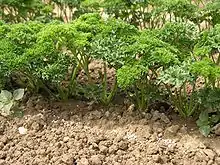Apiin
Apiin ist eine chemische Verbindung aus der Gruppe der Flavon-Glycoside.
| Strukturformel | |||||||||||||||||||
|---|---|---|---|---|---|---|---|---|---|---|---|---|---|---|---|---|---|---|---|
 | |||||||||||||||||||
| Allgemeines | |||||||||||||||||||
| Name | Apiin | ||||||||||||||||||
| Andere Namen |
| ||||||||||||||||||
| Summenformel | C26H28O14 | ||||||||||||||||||
| Kurzbeschreibung |
schwer entzündbar, weiß, geruchlos[1] | ||||||||||||||||||
| Externe Identifikatoren/Datenbanken | |||||||||||||||||||
| |||||||||||||||||||
| Eigenschaften | |||||||||||||||||||
| Molare Masse | 564,49 g·mol−1 | ||||||||||||||||||
| Aggregatzustand |
fest[1] | ||||||||||||||||||
| Löslichkeit |
132 g·l−1 (20 °C)[1] | ||||||||||||||||||
| Sicherheitshinweise | |||||||||||||||||||
| |||||||||||||||||||
| Soweit möglich und gebräuchlich, werden SI-Einheiten verwendet. Wenn nicht anders vermerkt, gelten die angegebenen Daten bei Standardbedingungen. | |||||||||||||||||||
Eigenschaften
Apiin ist ein brennbarer, schwer entzündbarer Stoff. Bei Raumtemperatur sind seine Kristalle weiß und geruchlos. Apiin zersetzt sich bei Erhitzung über 262–264 °C.[1] Das Aglykon des Apiins ist Apigenin. Endständig befindet sich eine Apiose. Apiin ist entzündungshemmend durch eine Hemmung der iNOS.[2]
Vorkommen

Krause Petersilie
.jpg.webp)
Sedum caeruleum
Apiin kommt in der Petersilie,[3][4] im Sellerie (Apium graveolens), in Brennnesseln[5] und in Sedum caerulaeum vor.[6][7]
Verwendung
Apiin wird als Reduktionsmittel und Stabilisator bei der Herstellung sphärischer Kolloide aus Gold oder Silber verwendet.[8]
Einzelnachweise
- Datenblatt Apiin, ≥97.0% (HPLC) bei Sigma-Aldrich, abgerufen am 4. August 2016 (PDF).
- T. Mencherini, A. Cau, G. Bianco, R. Della Loggia, R. P. Aquino, G. Autore: An extract of Apium graveolens var. dulce leaves: structure of the major constituent, apiin, and its anti-inflammatory properties. In: The Journal of pharmacy and pharmacology. Band 59, Nummer 6, Juni 2007, S. 891–897, doi:10.1211/jpp.59.6.0016, PMID 17637182.
- H. Meyer, A. Bolarinwa, G. Wolfram, J. Linseisen: Bioavailability of Apigenin from Apiin-Rich Parsley in Humans. In: Ann Nutr Metab. 50, Nr. 3, 2006, S. 167–172. doi:10.1159/000090736. PMID 16407641.
- M. H. Farzaei, Z. Abbasabadi, M. R. Ardekani, R. Rahimi, F. Farzaei: Parsley: a review of ethnopharmacology, phytochemistry and biological activities. In: Journal of traditional Chinese medicine = Chung i tsa chih ying wen pan / sponsored by All-China Association of Traditional Chinese Medicine, Academy of Traditional Chinese Medicine. Band 33, Nummer 6, Dezember 2013, S. 815–826, doi:10.1016/S0254-6272(14)60018-2, PMID 24660617.
- Quantitative determination of plant phenolics in Urtica dioica extracts by high-performance liquid chromatography coupled with tandem mass spectrometric detection. In: Food Chemistry. Band 143, 15. Januar 2014, S. 48–53, doi:10.1016/j.foodchem.2013.07.097.
- S. R. Gupta, T. R. Seshadri: A study of apiin from the parsley seeds and plant. In: Proceedings of the Indian Academy of Sciences - Section A. Band 35, Nr. 5, Mai 1952, S. 242–248, doi:10.1007/BF03172503.
- C. Bensouici, A. Kabouche, A. Karioti, M. Öztürk, M. E. Duru, A. R. Bilia, Z. Kabouche: Compounds from Sedum caeruleum with antioxidant, anticholinesterase, and antibacterial activities. In: Pharmaceutical biology. Band 54, Nummer 1, 2016, S. 174–179, doi:10.3109/13880209.2015.1028078, PMID 25845643.
- J. Kasthuri, S. Veerapandian, N. Rajendiran: Biological synthesis of silver and gold nanoparticles using apiin as reducing agent. In: Colloids and surfaces. B, Biointerfaces. Band 68, Nummer 1, Januar 2009, S. 55–60, doi:10.1016/j.colsurfb.2008.09.021, PMID 18977643.
This article is issued from Wikipedia. The text is licensed under Creative Commons - Attribution - Sharealike. The authors of the article are listed here. Additional terms may apply for the media files, click on images to show image meta data.